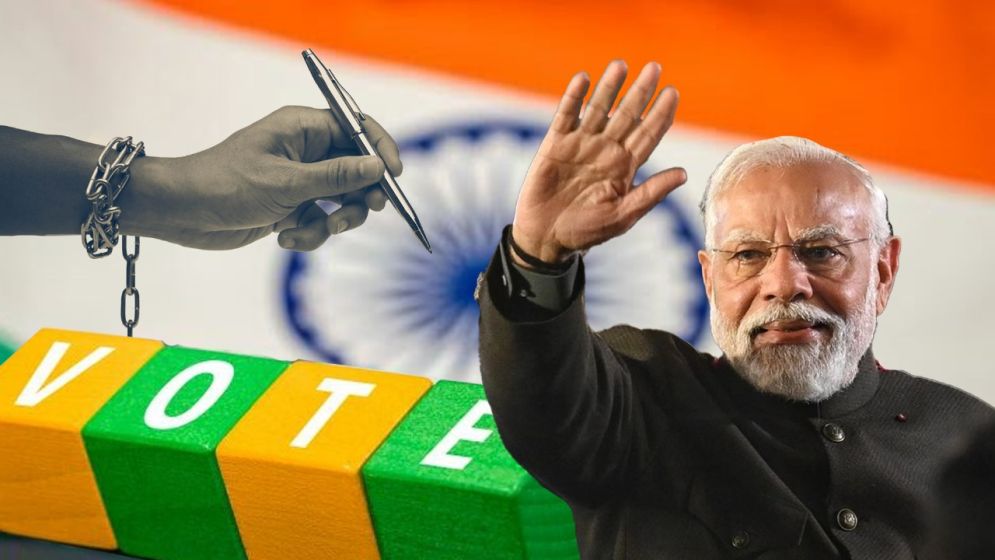What election coverage has taught me about the state of “independent” journalism in India

In mid-April this year, at the height of the blazing Delhi summer, two men in suits walked into the Scroll office.
My colleagues froze. Some mentally cursed themselves for not downloading a program we'd recently heard about that wipes your phone clean with a single click.
Others likely recalled the recent tax raids on the BBC’s Delhi offices, which followed the airing of a documentary about Indian Prime Minister Narendra Modi— a documentary that his Bharatiya Janata Party government swiftly blocked on platforms like YouTube and Twitter.
Not long before, our colleagues at independent media outlets such as Newslaundry and The Quint had also been targeted by the tax authorities, as had a foundation dedicated to supporting independent journalism in India.
It turns out that the men in suits were simply representatives from a bank, making an unsolicited pitch to sell us new accounts.
However, their unexpected appearance triggered a wave of tension, reflecting the anxiety that many independent media outlets in India feel, especially as the country approached election season.
The pressures we've faced since Modi’s ascent to power in 2014 are mirrored in India’s declining position on the Press Freedom Index published by Reporters Without Borders.
Last year, India's rank dropped to 161 out of 180 countries, down from 150 the year before.
The Indian government employs a range of tactics to control and silence the media. It regularly blocks tweets and YouTube videos that it deems harmful to national interests.
Its Press Information Bureau seeks to discredit journalists by sending out tweets declaring stories false—without offering any explanation or evidence.
There are also troll farms aimed at intimidating critics, and the government frequently uses the tax authorities to entangle dissenters in bureaucratic red tape, choking their operations.
Journalists who remain particularly defiant often find themselves jailed. This is especially true in Kashmir, where several journalists have been arrested on charges of aiding terrorism and sedition.
-676e7ee6ecd25.png)
Independent
media faces the ire
The contrast between India’s independent media, which faces increasing wariness, and the buoyant mainstream media, is stark.
Nearly all national news television channels have transformed into propaganda outlets for the ruling Bharatiya Janata Party (BJP). There are two main reasons for this shift.
Many journalists in India’s newsrooms align themselves with the majoritarian agenda of the ruling party. Additionally, the government spends approximately $20 million on advertising—funds that are crucial for the survival of many media organizations.
This vision of partisan journalism was laid out openly in March by India Today’s executive editor-in-chief during the media group’s annual conclave. “The media cannot play the role of the Opposition,” she stated.
“If the Opposition is in disarray, the media cannot be blamed for it. We cannot present another side equally or strongly if it doesn’t exist. We are observers in this boxing match, not players. If one side is weak or doesn't show up, we cannot jump into the ring. This is not fear; it’s a matter of rules, roles, and competence. We are the medium, not the message."
It felt as though she was rejecting the very values of courage and accountability that her own publication had long championed.
But by invoking these imagined rules, she highlighted one of the central challenges facing the media today—not just in India, but globally.
It was as if the media had entered a stadium to cover a children’s game of tag, or perhaps kabaddi, but one team was playing as if it were engaged in a brutal mixed martial arts match.
They were punching, kicking, and putting their opponents in headlocks, while the media, bound by the conventions of objectivity and detachment, lacked the framework to call out these tactics.
-676e7f4e85fab.png)
The media’s
manufactured contents
India's mainstream media was so successful in dominating the national discourse in the months leading up to the Lok Sabha elections that it became widely accepted wisdom that Modi and the BJP's victory was inevitable.
Even amidst an electoral financing scandal involving business deals in exchange for political contributions, opinion polls overwhelmingly favored the Hindutva party.
Many of us in the independent media entered the field already accepting this assumption.
If the elections seemed like a foregone conclusion, we reasoned that our role would be to remind our audience of the costs India had paid for its democratic erosion over the past decade.
With some opposition leaders imprisoned and the Congress party's accounts frozen, we also felt the urgency of stressing that this was no ordinary election.
The week before India’s 2024 elections, which were set to unfold over seven phases and stretch across 44 days, we at Scroll published an article titled, “Elections are India’s greatest festival – so why is this one so dull?”
However, as the election progressed, my colleagues began to realize that the reality on the ground was far more volatile than what the mainstream media and opinion polls were suggesting.
Supriya Sharma, one of my sharpest colleagues, reported that the mood in Uttar Pradesh—a state that sends the largest number of MPs to the Lok Sabha and was considered the BJP’s strongest bastion—was shifting.
It became evident to us that the Hindutva party was likely to enter the elections with a diminished mandate.
In the end, the BJP fell short of securing an outright majority on its own, ultimately having to form a coalition government with allies.
Election reporting, of course, is not an exact science. The expertise of political journalists is built over years in the field, learning about India’s complex social fabric and staying attuned to subtle changes in this landscape.
Perhaps the most significant challenge many Indian journalists faced in this election was their reluctance to fully understand and embrace what ordinary people were telling them.
—-
Naresh Fernandes is the editor of Scroll.in

